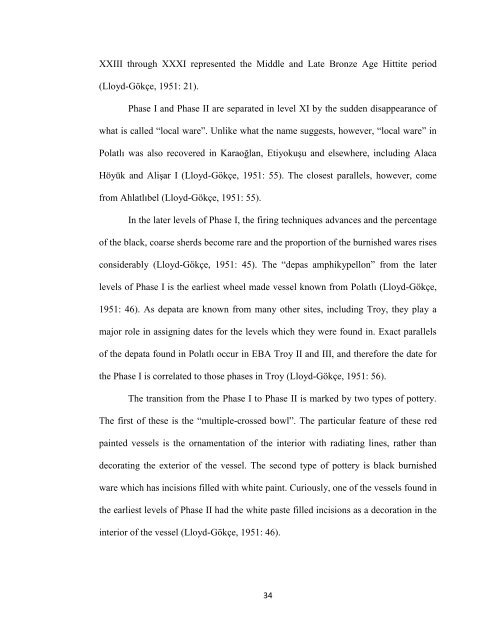EARLY BRONZE AGE DAGGERS IN CENTRAL ... - Bilkent University
EARLY BRONZE AGE DAGGERS IN CENTRAL ... - Bilkent University
EARLY BRONZE AGE DAGGERS IN CENTRAL ... - Bilkent University
Create successful ePaper yourself
Turn your PDF publications into a flip-book with our unique Google optimized e-Paper software.
XXIII through XXXI represented the Middle and Late Bronze Age Hittite period<br />
(Lloyd-Gökçe, 1951: 21).<br />
Phase I and Phase II are separated in level XI by the sudden disappearance of<br />
what is called “local ware”. Unlike what the name suggests, however, “local ware” in<br />
Polatlı was also recovered in Karaoğlan, Etiyokuşu and elsewhere, including Alaca<br />
Höyük and Alişar I (Lloyd-Gökçe, 1951: 55). The closest parallels, however, come<br />
from Ahlatlıbel (Lloyd-Gökçe, 1951: 55).<br />
In the later levels of Phase I, the firing techniques advances and the percentage<br />
of the black, coarse sherds become rare and the proportion of the burnished wares rises<br />
considerably (Lloyd-Gökçe, 1951: 45). The “depas amphikypellon” from the later<br />
levels of Phase I is the earliest wheel made vessel known from Polatlı (Lloyd-Gökçe,<br />
1951: 46). As depata are known from many other sites, including Troy, they play a<br />
major role in assigning dates for the levels which they were found in. Exact parallels<br />
of the depata found in Polatlı occur in EBA Troy II and III, and therefore the date for<br />
the Phase I is correlated to those phases in Troy (Lloyd-Gökçe, 1951: 56).<br />
The transition from the Phase I to Phase II is marked by two types of pottery.<br />
The first of these is the “multiple-crossed bowl”. The particular feature of these red<br />
painted vessels is the ornamentation of the interior with radiating lines, rather than<br />
decorating the exterior of the vessel. The second type of pottery is black burnished<br />
ware which has incisions filled with white paint. Curiously, one of the vessels found in<br />
the earliest levels of Phase II had the white paste filled incisions as a decoration in the<br />
interior of the vessel (Lloyd-Gökçe, 1951: 46).<br />
34
















